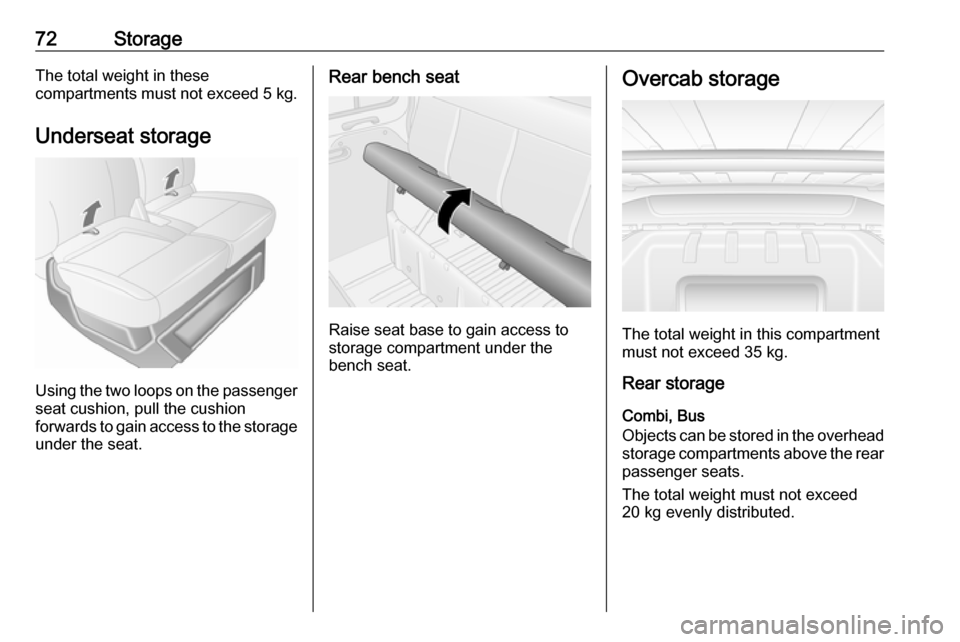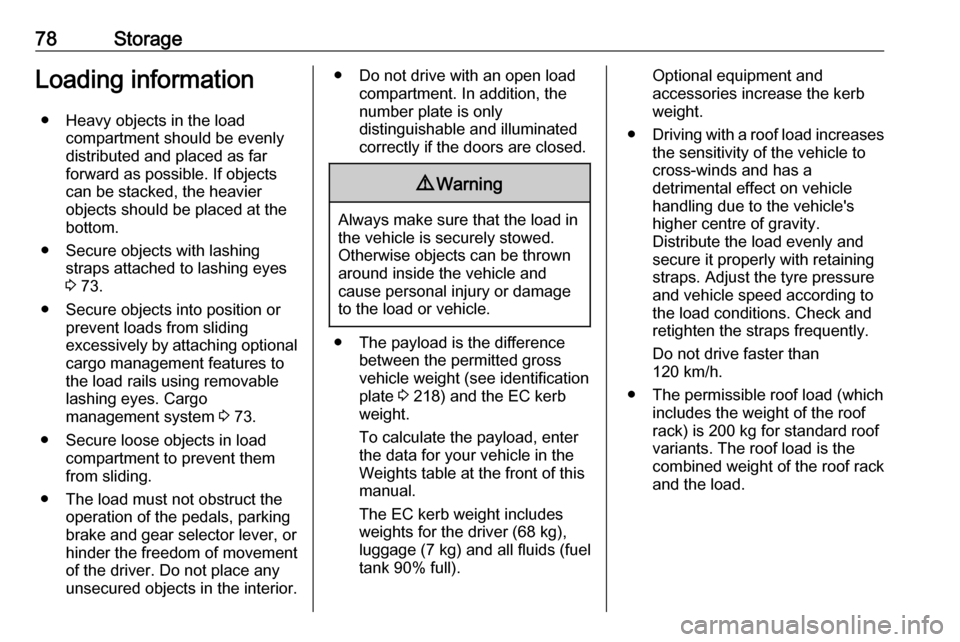weight OPEL MOVANO_B 2017 Owner's Manual
[x] Cancel search | Manufacturer: OPEL, Model Year: 2017, Model line: MOVANO_B, Model: OPEL MOVANO_B 2017Pages: 255, PDF Size: 6.12 MB
Page 30 of 255

28Keys, doors and windowsThe sliding side door can be locked
from inside the vehicle with the
interior lock switch.
Ensure the side door is fully closed
and secure before driving the vehicle.9 Warning
Take care when operating the
sliding side door. Risk of injury.
Ensure that nothing becomes
trapped during operation and no-
one is standing within the moving
area.
If the vehicle is parked on a slope,
open sliding doors may move
accidentally on account of their
weight.
Close the sliding doors before
driving off.
9 Danger
Do not drive with the sliding side
door open or ajar, e.g. when
transporting bulky objects, since
toxic exhaust gases, which cannot
be seen or smelled, could enter
the vehicle. This can cause
unconsciousness and even death.
Central locking system 3 23.
Power sliding door
Opening
With vehicle at a standstill and the
parking brake applied, press switch
on instrument panel to open the
power sliding door automatically; the
LED in the switch flashes during
operation.
If the switch is pressed while the
engine is in an Autostop, the engine
will restart automatically.
Stop-start system 3 132.
Note
If the parking brake is not applied when the switch is pressed, a
warning chime will sound and the
power sliding door will not open.
To stop movement at any time, press
the switch again. Press once more to
continue power sliding door
movement.
Note
If the power sliding door is locked
from the inside with the child lock
active, a warning chime will sound.
Unlock the door manually from the
inside.
Closing
Press switch again; the LED flashes and a chime sounds during operation.
In the event of opening or closing
difficulties, e.g. due to frost, press and
hold the switch to increase power to
the sliding door.
Page 65 of 255

Seats, restraints63Child restraint installation locations
Permissible options for fitting a child restraint system Front seats - All variantsWeight and age classSingle seat - front passenger side 1)Bench seat - front passenger sidewithout airbagwith airbagwithout airbagwith airbagcentreoutercentreouterGroup 0: up to 10 kg
or approx. 10 months
Group 0+: up to 13 kg
or approx. two years
UU 2)UUU 2)U2)
Group I: 9 to 18 kg
or approx. eight months to four yearsUU 2)UUU2)U 2)Group II: 15 to 25 kg
or approx. three to seven years
Group III: 22 to 36 kg
or approx. six to 12 years
UU 2)UUU 2)U2)
1)
If adjustable, ensure seat is in its rearmost position. Make sure vehicle seat belt is as straight as possible between shoulder and
upper anchorage point.
2) Ensure the front passenger airbag system is deactivated when installing a child restraint in this position.
Page 66 of 255

64Seats, restraintsDoublecab - rear seatsWeight and age class2nd row seatsOuterCentreGroup 0: up to 10 kg
or approx. 10 months
Group 0+: up to 13 kg
or approx. two years
UX
Group I: 9 to 18 kg
or approx. eight months to four yearsUXGroup II: 15 to 25 kg
or approx. three to seven years
Group III: 22 to 36 kg
or approx. six to 12 years
UX
Page 67 of 255

Seats, restraints65Combi - rear seatsWeight and age class2nd row seats3rd row seatsDriver side
outer seat
Centre seat
Passenger side
outer seatGroup 0: up to 10 kg
or approx. 10 months
Group 0+: up to 13 kg
or approx. two years
U 3)
,
or approx. eight months to four yearsU 4)
,
Group III: 22 to 36 kg
or approx. six to 12 years
U 4)UF 4)UF4)X
3)
Move the front seat as far forward as possible to install a rear facing child seat, then move back the seat in front in accordance with
the child seat instructions.
4) Forward facing child seat; position the seatback of the child seat in contact with the seatback of the vehicle seat. Adjust the height
of the headrest or remove it if necessary; do not push the seat in front of the child more than halfway back on its runners and do not recline the seatback more than 25°.
Page 68 of 255

66Seats, restraintsBus - rear seatsWeight and age classRear seatsGroup 0: up to 10 kg
or approx. 10 months
Group 0+: up to 13 kg
or approx. two years
X
Group I: 9 to 18 kg
or approx. eight months to four yearsXGroup II: 15 to 25 kg
or approx. three to seven years
Group III: 22 to 36 kg
or approx. six to 12 years
X
Page 69 of 255

Seats, restraints67Crew cab - rear seatsWeight and age class2nd row seatsOuterCentreGroup 0: up to 10 kg
or approx. 10 months
Group 0+: up to 13 kg
or approx. two years
UX
Group I: 9 to 18 kg
or approx. eight months to four yearsUXGroup II: 15 to 25 kg
or approx. three to seven years
Group III: 22 to 36 kg
or approx. six to 12 years
UX
U:suitable for universal category restraint systems for use in this weight and age class, in conjunction with three-point
seat belt.UF:suitable for universal category forward-facing restraint systems for use in this weight and age class, in conjunction
with three-point seat belt.<:suitable for ISOFIX child restraint system with mounting brackets and anchorage points, where fitted. When mounting
an ISOFIX child restraint system, only systems that have been approved for the vehicle may be used. Refer to
" Permissible options for fitting an ISOFIX child restraint system ".X:seat position not suitable for children in this weight and age class.
Page 70 of 255

68Seats, restraintsPermissible options for fitting an ISOFIX child restraint systemCombiWeight classSize
classFixtureFront
seats2nd row seats3rd row
seatsDriver side
outer seatCentre
seatPassenger side
outer seatGroup 0: up to 10 kg
or approx. 10 monthsEISO/R1XILXXXGroup 0+: up to 13 kg
or approx. two yearsEISO/R1XILXXXDISO/R2XILXXXCISO/R3XILXXXGroup I: 9 to 18 kg
or approx. eight months to four yearsDISO/R2XILXXXCISO/R3XILXXXBISO/F2XIL, IUFIL, IUFXXB1ISO/F2XXIL, IUFIL, IUFXXAISO/F3XIL, IUFIL, IUFXXIL:suitable for particular ISOFIX restraint systems of the "specific-vehicle", "restricted" or "semi-universal" categories.
The ISOFIX restraint system must be approved for the specific vehicle type.IUF:suitable for ISOFIX forward-facing child restraint systems of universal category approved for use in this weight class.X:no ISOFIX child restraint system approved in this weight class.
Page 71 of 255

Seats, restraints69ISOFIX size class and seat deviceA - ISO/F3:forward-facing child restraint system for children of maximum size in the weight class 9 to 18 kg.B - ISO/F2:forward-facing child restraint system for smaller children in the weight class 9 to 18 kg.B1 - ISO/F2X:forward-facing child restraint system for smaller children in the weight class 9 to 18 kg.C - ISO/R3:rear-facing child restraint system for children of maximum size in the weight class up to 18 kg.D - ISO/R2:rear-facing child restraint system for smaller children in the weight class up to 18 kg.E - ISO/R1:rear-facing child restraint system for young children in the weight class up to 13 kg.
Page 74 of 255

72StorageThe total weight in these
compartments must not exceed 5 kg.
Underseat storage
Using the two loops on the passenger seat cushion, pull the cushion
forwards to gain access to the storage
under the seat.
Rear bench seat
Raise seat base to gain access to
storage compartment under the
bench seat.
Overcab storage
The total weight in this compartment
must not exceed 35 kg.
Rear storage
Combi, Bus
Objects can be stored in the overhead
storage compartments above the rear passenger seats.
The total weight must not exceed
20 kg evenly distributed.
Page 80 of 255

78StorageLoading information● Heavy objects in the load compartment should be evenlydistributed and placed as far
forward as possible. If objects
can be stacked, the heavier
objects should be placed at the
bottom.
● Secure objects with lashing straps attached to lashing eyes
3 73.
● Secure objects into position or prevent loads from sliding
excessively by attaching optional
cargo management features to
the load rails using removable
lashing eyes. Cargo
management system 3 73.
● Secure loose objects in load compartment to prevent themfrom sliding.
● The load must not obstruct the operation of the pedals, parking
brake and gear selector lever, or
hinder the freedom of movement of the driver. Do not place any
unsecured objects in the interior.● Do not drive with an open load compartment. In addition, the
number plate is only
distinguishable and illuminated correctly if the doors are closed.9 Warning
Always make sure that the load in
the vehicle is securely stowed.
Otherwise objects can be thrown
around inside the vehicle and
cause personal injury or damage
to the load or vehicle.
● The payload is the difference between the permitted gross
vehicle weight (see identification
plate 3 218) and the EC kerb
weight.
To calculate the payload, enter
the data for your vehicle in the
Weights table at the front of this
manual.
The EC kerb weight includes
weights for the driver (68 kg),
luggage (7 kg) and all fluids (fuel
tank 90% full).
Optional equipment and
accessories increase the kerb
weight.
● Driving with a roof load increases
the sensitivity of the vehicle to
cross-winds and has a
detrimental effect on vehicle
handling due to the vehicle's
higher centre of gravity.
Distribute the load evenly and secure it properly with retaining
straps. Adjust the tyre pressure
and vehicle speed according to
the load conditions. Check and
retighten the straps frequently.
Do not drive faster than
120 km/h.
● The permissible roof load (which includes the weight of the roof
rack) is 200 kg for standard roof
variants. The roof load is the combined weight of the roof rack
and the load.